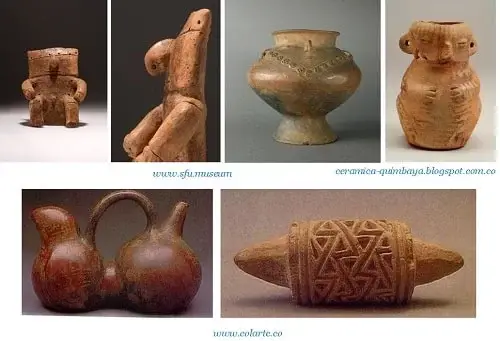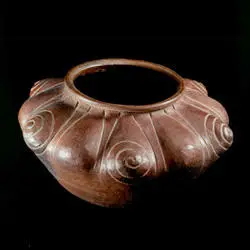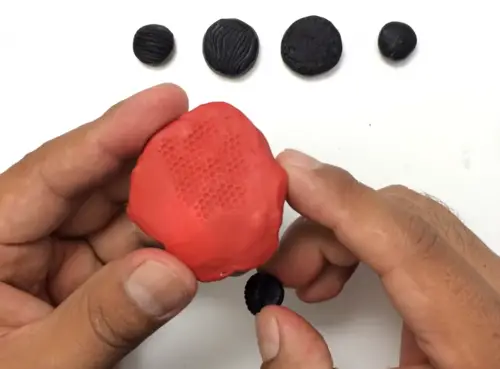Translated by Nick R
If you are involved in the world of pottery, you will know that thanks to its history and years of tradition, there are several types of ceramics representative of cultures from all over the world.
For instance, there are cultures called pre-Columbian, which are the ones that existed long before the arrival of Christopher Columbus to America in 1942. Today there is a record of many of these cultures, for example, Tayrona, Inca, and Maya.
In today’s blog, we will talk about a really relevant type, the Quimbaya pottery in Colombia. Let’s start!
Table of Contents
What is Quimbaya pottery?
Quimbaya pottery is a highly appreciated artistic practice that owes its name to the tribe responsible for its creation, the Quimbaya Tribe.
The Quimbaya Tribe comes from Colombia, specifically from the departments of Caldas, which includes cities and municipalities such as Chinchiná, Palestina, Villamaría and Manizales; Risaralda, cities and municipalities such as Pereira, Marsella and Santa Rosa; and Quindío, with places such as Armenia, Quimbaya, Montenegro, La Tebaida, Salento and Circasia. Furthermore, the ethnic group was also present in the municipalities of Cartago and Obando, situated in the north of Valle de Cauca.
Quimbaya Pottery is one of the best and most beautiful ceramics in the country, so much so that it is said it can compete on a continental level with other types of pottery. Simply wonderful!
Characteristics of Quimbaya pottery
Quimbaya pottery is great and unique, and thus, below, we show you its main characteristics, which help it stand out from other types of pottery.
- Quimbaya pottery is recognized for its decoration with geometric patterns, like circles, lines, squares, etc.
- All Quimbaya ceramic pieces have globular shapes, which means they look like a globe for they are large and round.
- The Quimbaya ceramic pieces are painted or decorated using the negative painting technique; rather than painting the drawings that decorate these objects, they painted the outside of the designs.
- Both monochrome and polychrome paints are used in Quimbaya ceramics. Monochrome painting consists of painting the objects in a single color. While polychrome painting involves using several colors to paint a single piece. You can mix them or place them separately to be differentiated from each other.
History of Quimbaya pottery
As you could read before, Quimbaya pottery has a history to be told, and today, we will explain it, so you can learn more about its origin and significance.
The history of Quimbaya pottery began in 500 B.C. and extended until 600 A.D. in civilizations that, by then, were dedicated to agriculture, hunting, fishing, and food gathering, such as wild fruits. They also focused on the extraction of gold and sand to make objects that served not only for domestic use but also as offerings, exchanges, or rituals.
Potters and goldsmiths used to make ceramic and gold pieces that depicted the aspects of the social organization and the thought or beliefs of their communities, some of which were inspired by female figures and fruits.
Among the objects that the Quimbayas produced are human figures, bowls, vases, jugs, bowls, musical instruments, and flagons, which are tall and large vessels.
Usually, when depicting human figures, they had well-defined features such as nudity, prominent cheekbones, slanted eyes, a thick torso, and a triangular face. In addition, they accompanied these figures with ornaments, such as necklaces, earrings, nose rings, and crowns that were symbols of this cultural group.
During this period, ceramic urns’ creations stood out. These urns were bowls of various sizes and shapes, from round and flat to rustic finishes.
The decorations included drawings of pumpkin and squash fruits, birds, circular shapes, and female figures curled up or carrying a belly that makes them look pregnant or like giving birth.
Ceramic urns were used for two specific tasks. The first, like bowls for depositing food or fresh harvests. The second, and undoubtedly the most significant, was burial urns, as these objects symbolized something symbolic about life and death.
The ashes of the dead, commonly animals (birds), were kept in the urns, which had to have a lid to be buried. These items would be placed in shallow pits approximately 50 to 150 cm deep, sometimes stones were placed on top or around the grave to show respect for the space as something sacred. However, urns have been found near or under the terraces of the houses in these communities.
Besides the previous items, people of that time made realistic figures of animals such as snails, butterflies, and insects in metamorphosis because, for them, these had significance related to the cycles of nature and society.
By the year 800 A.D., both the population and the agricultural, textile, ceramic, and goldsmithing sectors grew, so they began to make advances and improvements in the ancient techniques for making their pieces.
First, human figures became more and more realistic, as they were depicted in different postures to communicate the social group or rank to which they belonged. Some of these figures were buried with the deceased bodies to accompany and protect them.
Another advance of this period was the creation of paint applying techniques using stamps and ceramic rollers to their pieces and even to people as part of a cultural tradition.
The elaboration and decoration of ceramics varied from one area to another. On the south, the pieces were made in different shapes and decorated with red paint on the bottom and black paint on top. On the north of Cauca, instead, the wares were painted in brown and gray or orange with white decorations.
Main pieces of Quimbaya pottery
As we told you in the previous section, the Quimbaya tribe made many ceramic pieces, and here are the most representative ones.
Vessels of composite silhouette
This type of vessel is characterized by its form, as it is constantly compared to the construction of a house; the walls and mouth resemble the shape of a classic dwelling.
These vessels were used to store and transport food from one place to another.
Globular vessels and bowls
The globular vessels and bowls were the most known pieces of the Quimbayas since they were used both in domestic and ceremonial contexts.
Because of their utility, several of these objects have been found in the region of Quindío, Colombia. Their designs and decoration are really varied as some have drawings of animals such as snakes and toads or curved and straight patterns.
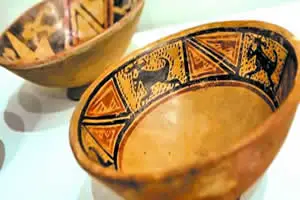
Whistling vessels
The whistling vessels are considered one of the most complex and beautiful creations of the Quimbaya community.
This piece consists of multiple pieces joined together. The first is a kind of vase with a whistle tip, and the second one consists of a human-like figure. It calls the attention that the mouth of what seems to be a human face turns into a circle as if it were blowing. Both pieces are attached by a third piece that resembles a handle from which they are grasped.
The whistling vessels are wind instruments that were generally used for different ceremonies. You probably want to see what we are talking about, well, here is a picture.
Cups
Cups or goblets are undoubtedly the most known pieces of the Quimbaya tribe. They were used to transport or store drinks and also in various ceremonies.
These pieces are decorated using negative painting, that is, red paint on black. The red painting is used to paint strokes that leave black shapes. This technique may sound quite strange, but the results are unique and worth appreciating as it required great imagination and an excellent pulse from the potter to obtain a beautifully decorated piece.
Due to its popularity, several cups have been found across Colombia, particularly in the departments of Magdalena, Santander, Norte de Santander, Boyacá, Cundinamarca, Antioquia, Caldas, Valle, Huila, Tolima, Nariño, Chocó, Córdoba, Bolívar, Atlántico and Putumayo.
Alcazarras
Alcazarras are objects with spheroid form imitating the legs and faces of animals such as birds or frogs. In addition, they incorporated a handle from which they grasped the pieces.
The Quimbaya people used them for cooking, decoration, and religious purposes. Moreover, some of these pieces had a small top hole or hollow through which it emitted a sound similar to a bird’s song.
These pieces were decorated with ocher, white and black paint, but most of them were other. Here is an image of one of these curious pieces.
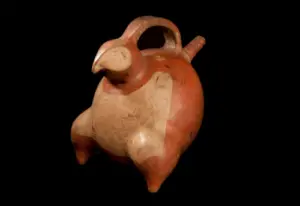
Urns
We talked a little about these objects when we told you the history of this kind of pottery. Remember that urns are round bowls used to bury the ashes of several deceased members of the tribe or sometimes animals such as birds.
The urns are characterized by their reddish, ochre, or brown color and their decoration, including fruits, animals, and female figures in a pregnancy state or giving birth.
Where can these pieces be found?
We know that Quimbaya pottery caught your attention and that you would like to appreciate it up close to learn more about it. Therefore, we will now show you the places where you can currently find all these great pieces.
Quimbaya Gold Museum
The Quimbaya Gold Museum is located in the Center of the Bank of the Republic in the city of Armenia, department of Quindio.
It first opened its doors in 1986, aiming to make tribute to the indigenous peoples who inhabited the Cauca region from its beginnings and during the arrival of the Spaniards.
If you visit this museum, you will find, within its halls, archaeological artifacts that have been found and proven to belong to the Quimbaya tribe. You should know that, as well as the ceramic pieces, you will also encounter gold works since pottery and goldsmithing were the occupations for which this community stood out.
Most of the pieces were elaborated approximately between the IV century B.C. and the XVI century AD. So through these, you can discover, understand and learn about the lifestyle of this ethnic group.
Extra information
If you are interested in visiting this museum, here is some information such as address, fees, schedules and the website of the place.
Address: Banco de la República Building, Cra. 16 # 21 – 14, Armenia, Quindío.
Price: Free admission for all public.
Schedule:
Monday to Friday: 8:00 a.m. to 1:00 p.m.
Saturdays and Sundays: closed
Website: https://www.banrepcultural.org/redireccion/bienvenidos-al-museo-del-oro-quimbaya
Hall of Archaeological Exhibit of the University of Quindío
This room is located on the First Floor of the University of Quindío inside the Fine Arts Institute.
In this exhibition, you will be able to appreciate more than 2900 pieces that have been collected over the years in the department of Cauca, Colombia. Among them, you will find ceramic, metal, and gold pieces.
The mission of this exhibit is to preserve and raise awareness of the regional archaeological heritage. This way, people also have a space where to exchange knowledge about the cultures and learn about the cultural background of each one of them.
You must know that this space also supports those teachers and students who want to do research on cultural heritage and archeology. Magnificent, don’t you think?
Extra information
And knowing that you may want to visit this place to appreciate the Quimbaya pottery, here is some extra information for your visit to this place.
Address: Carrera 16 #20-15, Armenia, Quindío, Colombia.
Schedule:
Monday to Friday: 8:00 a.m. to 12:00 p.m. and 02:00 p.m. to 6:00 p.m.
Contact
E-mail: alaarqueologicauq@uniquindio.edu.co
Phone number: 7412008
To go to the Archaeological Exhibit Hall at the University of Quindío, you must book your visit in advance. So, if you decide to go, you can make reservations through the email or phone number we shared above and consult the entrance fee.
That’s all for today’s blog. What do you think? For us, it was great to learn more about Quimbaya pottery and its importance in the development of Colombian culture.
Remember that if you are interested in learning more about the history of ceramics, you can find articles on this topic in countries like China and Greece in our blog; or even better, dare to know another type of Colombian pottery such as the famous Chamba pottery and the Carmen de Viboral pottery.
Do not stop learning about the wonderful world of ceramics. You will be surprised every time, for sure.

